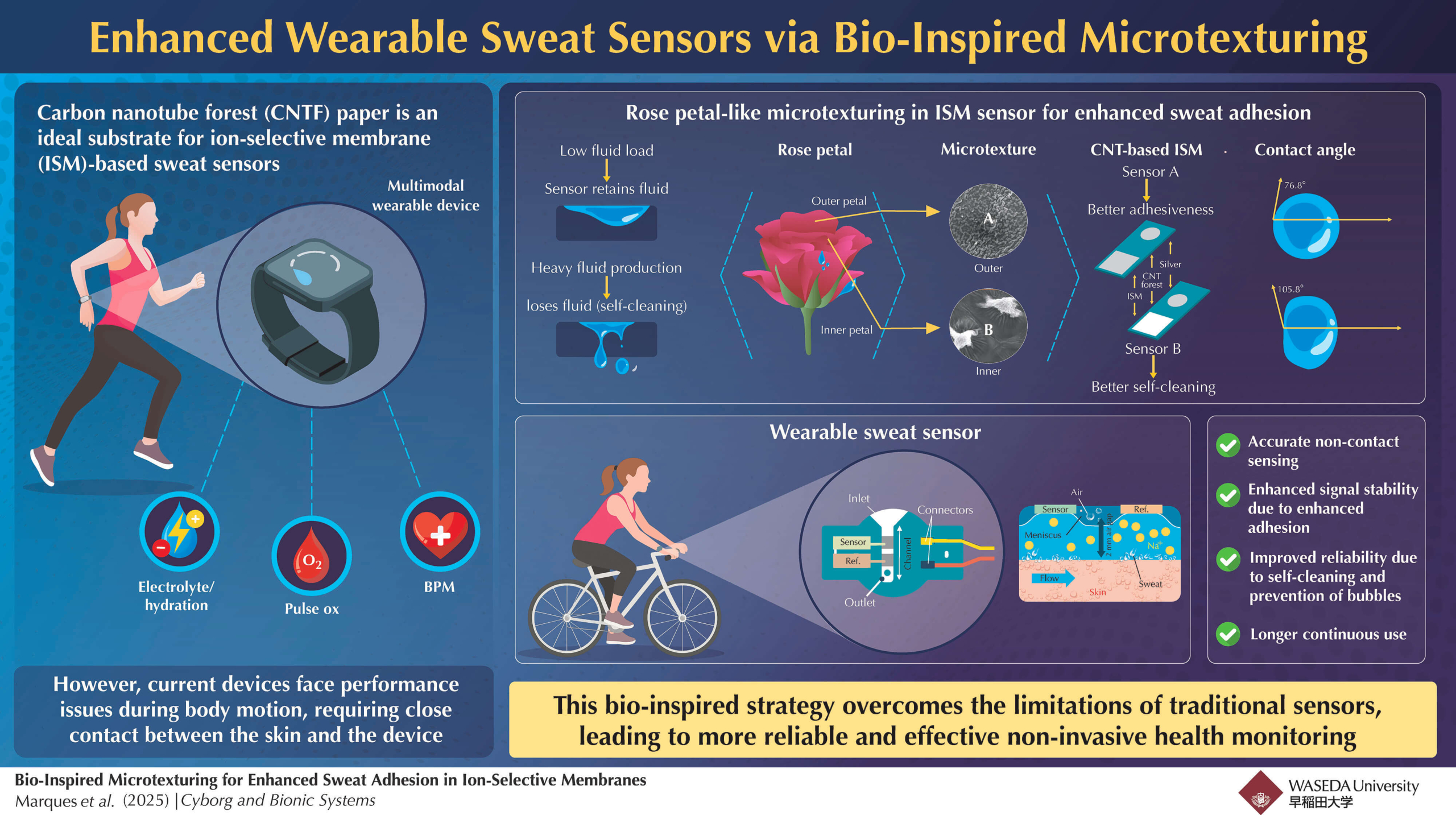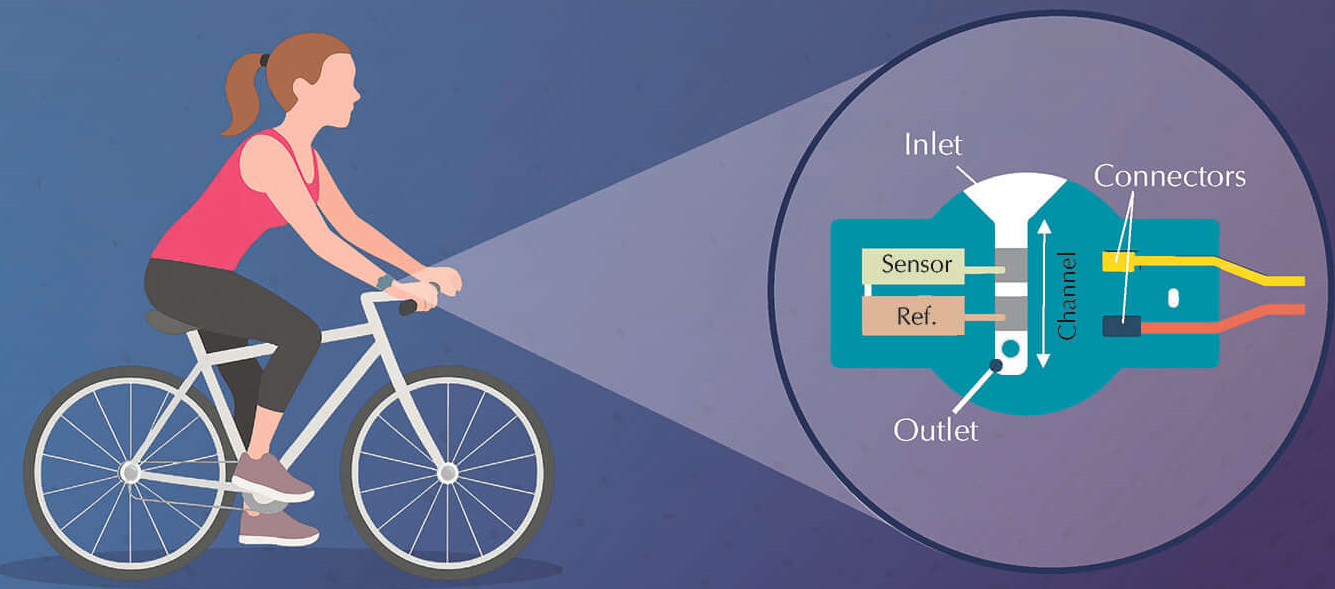Bio-Inspired, Self-Cleaning Sweat Sensors for Comfortable Wearable Health Monitoring
Thu, Aug 28, 2025-
Tags
Bio-Inspired, Self-Cleaning Sweat Sensors for Comfortable Wearable Health Monitoring
Researchers developed novel sweat sensors that mimic the microtexture of rose petals, enhancing stability, performance, and comfort
Conventional wearable sweat sensors utilize hydrophobic ion-selective membranes (ISMs) and require tight contact and adhesives to achieve signal stability. However, this can lead to user discomfort and skin-related diseases, necessitating the development of non-contact alternatives. In a new study, inspired by the self-cleaning behavior of rose petals, researchers developed novel ISM-based sweat sensors that feature enhanced signal stability and performance, avoid skin contact, and are reusable, making them practical for daily use.

Wearable sensors can help prevent critical health issues by continuously monitoring physiological factors in real time. Specifically, sweat monitoring can provide valuable insights into electrolyte balance and overall health. Sodium concentration in sweat is a key indicator of hydration and muscle performance. Thin film materials, such as carbon nanotubes (CNTs) and ion-selective membranes (ISMs), have become central to the development of wearable sweat sensors. CNTs offer high mechanical flexibility and electrical conductivity, and ISMs enable non-invasive detection of specific ions in sweat.
Unfortunately, ISMs are inherently hydrophobic, meaning that they repel water, and by extension, sweat. This leads to low signal stability and responsiveness. Additionally, body motion and friction often interfere with sensor readings, which is why most sweat sensors rely on tight contact with the skin or adhesives. However, tight contact can lead to user discomfort, while long-term adhesive use can negatively impact skin health, resulting in infections, irritation, and other risks.
To address these challenges, a research team, led by Ph.D. student Marc Josep Montagut Marques from the Department of Integrative Bioscience and Biomedical Engineering at Waseda University in Japan, developed a novel bio-inspired ISM. “Inspired by rose petals, we designed a microtextured ISM that enhances wettability and exhibits self-cleaning properties,” explains Marques. “This allowed us to avoid contact of the sensor with the skin, unlike conventional sensors that require sticky patches that need frequent replacement.”
The team included a Master’s student Takayuki Masuji from Waseda University, Assistant Professor Mohamed Adel from Helwan University in Egypt, Professor Ahmed M. R. Fath El-Bab from Egypt-Japan University of Science and Technology in Egypt, and Assistant Professor Kayo Hirose and Dr. Kanji Uchida from Tokyo University Hospital in Japan. Their study was published in the journal Cyborg and Bionic Systems on August 5, 2025.
Rose petals have a unique wetting behavior. When exposed to small amounts of water, they are hydrophilic, allowing droplets to stick. But when the amount of water exceeds a certain threshold, their surfaces become hydrophobic, triggering a self-cleaning effect that repels all water. By studying the microtexture of rose petals, the team found that inner petals feature fine micro-wrinkles, while outer petals had polygonal islands surrounded by wrinkles and spike-like protrusions in the center.
Using molds of both petal types, the team fabricated two polyvinyl chloride (PVC)-based ISMs layered onto CNT-forest substrates: Sensor A replicated the microtexture of the inner petals, and Sensor B mimicked the outer petals. Both sensors demonstrated significantly improved water retention in static conditions compared to conventional ISMs. Notably, Sensor A showed the highest water retention, making it suitable for sweat monitoring during movement. Additionally, both sensors demonstrated the self-cleaning effect when exposed to high water levels and showed enhanced electrochemical activity.
To demonstrate their potential, the researchers 3D-printed wearable sweat monitoring devices using these sensors. These devices used microchannels to carry sweat to the sensors, with a 2-millimeter gap to avoid skin contact, reducing skin irritation and improving user comfort. In running tests, the devices accurately monitored sodium concentrations in sweat, indicating electrolyte loss. Thanks to the self-cleaning feature, the sensors also demonstrated a sweat-recirculation mechanism, wherein during periods of low-sweat production, the sensors retained fluid within the channels, and once sweat levels increased above a limit, they triggered the self-cleaning process. This mechanism ensures signal stability and prevents the formation of bubbles that can cause sudden signal spikes.
“Our sensors offer a practical method for sweat monitoring. They don’t require direct contact with the skin, can be cleaned and reused, and are suitable for wearable devices like smart watches,” highlights Marques. “These sensors can also be integrated in prosthetic limbs and exoskeletons, informing intelligent feedback systems to prevent overexertion.”
The innovative rose-petal-inspired sensors present a promising step towards the development of comfortable, durable, and accurate wearable sweat monitoring systems.
Reference
Title of original paper: Bio-Inspired Microtexturing for Enhanced Sweat Adhesion in Ion-Selective Membranes
DOI:10.34133/cbsystems.0337
Journal: Cyborg and Bionic Systems
Article Publication Date: August 5, 2025
Authors: 1Marc Josep Montagut Marques, 2Takayuki Masuji, 3Mohamed Adel, 4Ahmed M. R. Fath El-Bab, 5Kayo Hirose, 5Kanji Uchida, 6Hisashi Sugime, 1,2Shinjiro Umezu
Affiliation:
1Department of Integrative Bioscience and Biomedical Engineering, Waseda University, Japan
2Department of Modern Mechanical Engineering, Waseda University, Japan
3Mechanical Engineering Department, Helwan University, Egypt
4Department of Mechatronics and Robotics Engineering, Egypt-Japan University of Science and Technology (E-JUST), Egypt
5Department of Anesthesiology and Pain Relief Center, The University of Tokyo Hospital, Japan
6Department of Applied Chemistry, Kindai University, Japan
About Mr. Marc Josep Montagut Marques
Marc Josep Montagut Marques is a Ph.D. student and is currently working as a Laboratory Research Assistant at the Umeshin Lab at Waseda University. His current research focuses on medical sensors, cyborg insects, machine vision and AI, solar cells. As a research engineer at ICFO, his line of research included opto engineering, sensor integration, nano fabrication, and lab-on-a-chip immunoassays.














